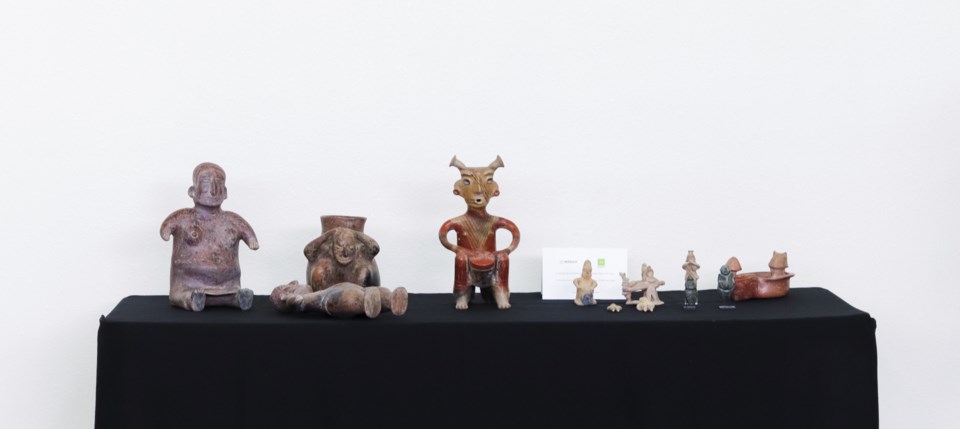Small, ancient sculptures that have been gathering dust in an Albuquerque storage box are returning home to Mexico, where they are intertwined with the identity of Indigenous communities.
The Albuquerque Museum Foundation celebrated the repatriation of the dozen sculptures in a ceremony Wednesday. The local Consulate of Mexico accepted Olmec greenstone sculptures, a figure from the city of Zacatecas, bowls that were buried with tombs and other clay figurines that date back thousands of years.
The event came as Native, Indigenous and African communities have pushed for museums, universities and other institutions to repatriate items that are important parts of their cultures and histories.
Foundation President and CEO Andrew Rodgers said returning the sculptur es that have sat in storage for 15 years was the right thing to do. Even the foundation's board agreed. But some outside their organization had a different idea.
"We did encounter a couple people who suggested ‘Oh you should just sell these’ ...'They may not be worth a ton so just keep them' or 'Mexico doesn’t really care about this kind of stuff,'" Rodgers said.
Mexico, however, very much cares.
“We appreciate and recognize actions taken by the Albuquerque Museum Foundation to voluntarily return these archaeological pieces back to the Mexican nation,” Consul of Mexico Norma Ang Sánchez said in a statement. “They are important elements of memory and identity for our native communities, and we are pleased they will be recovered.”
The effort to research the artifacts' origins began over five months ago when they were discovered sitting in a box in storage. Rodgers' assistant obtained the original appraisal form from when a donor gifted them in 2007.
“Immediately alarm bells started going off in our heads” when they saw the label “pre-Columbian,” Rodgers said.
Playing internet detective, Rodgers found the original dealer. A New York woman in her 90s still had the original notecards from the items' sale to the donors in 1985. She said they either were purchased on a roadside in Mexico or from dealers in New England.
“I don’t think anybody had mal intent. I just think there was not much clarity or much transparency in that sort of a practice 30, 40, 50 years ago,” Rodgers said.
Museum archaeologists at the University of New Mexico and Emory University in Atlanta authenticated the objects before talking with the local Mexican consulate. The Mexican National Institute of Anthropology and History, which will end up with the figures, believes they were made in western Mexico between 300 and 600 B.C.
There has always been a desire to reclaim pre-Hispanic culture and artwork, according to Tessa Solomon, a reporter for the online publication ARTnews who has covered dozens of stories on the topic.
When Andrés Manuel López Obrador became president of Mexico in 2018, his administration made retrieving artifacts a priority. Culture Minister Alejandra Frausto Guerrero has tried to stop sales of cultural items at auction. The efforts spawned a social media movement called #MyHeritageIsNotForSale. It's estimated more than 5,500 archaeological objects from Mexico have been recovered in the last few years.
“(Mexican officials) definitely have the most concerted effort to stop auction sales of these pieces,” Solomon said. Placing these objects in a European or American gallery or museum is “creating these gaps in the art history of these places that is difficult to fill. It shouldn’t be up to other countries to create these histories."
Campaigns to restore artifacts and artwork to a country or a people are happening worldwide. The U.S. Department of Interior is weighing changes to a federal law that ensures the repatriation of Native American remains and sacred objects. The proposed revisions include more clarity, specific deadlines and heavier penalties for violating the law.
to give up tens of thousands of artifacts and art. The Vatican says the feathered headdresses, carved walrus tusks, masks and embroidered animal skins were gifts to Pope Pius XI.
Germany and Nigeria to facilitate the return of hundreds of artifacts known as the Benin Bronzes that the British stole from Africa over a century ago. Hundreds of bronzes were sold to museums all over the world. The Smithsonian had 29 at its National Museum of African Art in Washington, D.C. They will go back to the Nigerian government.
Other Smithsonian museums have been returning objects to their rightful owners for more than three decades, said Kevin Gover, undersecretary for museums and culture. Determining who owns the items can be a lengthy process.
“Some of these things, remember, are often very old,” said Gover, a citizen of the Pawnee Nation of Oklahoma. “So it does require a great deal of research to be sure we understand exactly what it is and exactly how it was acquired ...I 'm impressed that this Albuquerque Museum (Foundation) had it done in six months.”
The racial reckoning that started in the U.S. in 2020 likely increased the number of calls for reclaiming antiquities and artwork. In April, the Smithsonian enacted an “ethical returns policy" that requires a look at how an object came into the institution's possession.
Museums and other art venues must face they are in an age where they will be judged by their actions, not just their artwork.
“The public is sort of expecting more from these institutions,” Gover said. “This is part of maintaining that trust, being able to say we came into possession of this object in an ethical way, in a fair way.”
Rodgers, of the Albuquerque Museum Foundation, is taking the ordeal as a key learning opportunity.
“This experience has especially given us exposure to this world and a better understanding," he said. “So I think we’re certainly much better prepared to make sure that we never accept anything we shouldn’t.”
Terry Tang, The Associated Press


.png;w=120;h=80;mode=crop)

